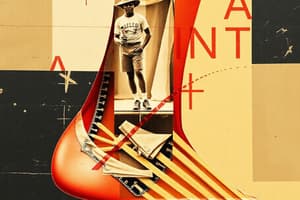Podcast
Questions and Answers
What is the primary purpose of the anterior talofibular ligament?
What is the primary purpose of the anterior talofibular ligament?
- Restricts plantarflexion of the ankle
- Prevents hyperextension of the ankle
- Resists inversion of the talus and calcaneus (correct)
- Resists posterior movement of the talus
Which of the following is NOT a common symptom of a Grade II ankle sprain?
Which of the following is NOT a common symptom of a Grade II ankle sprain?
- Moderate to severe edema
- Tenderness on the lateral ankle
- Chronic pain in the knee (correct)
- Antalgic gait
Which treatment is most effective immediately after an ankle sprain?
Which treatment is most effective immediately after an ankle sprain?
- Myofascial release
- Acetaminophen for pain relief
- RICE (Rest, Ice, Compression, Elevation) (correct)
- Strengthening peroneal muscles
What is the healing time for a Grade II lateral ankle sprain?
What is the healing time for a Grade II lateral ankle sprain?
Which ligament is the strongest of the lateral ligaments of the ankle?
Which ligament is the strongest of the lateral ligaments of the ankle?
Which grade of mobilization technique is specifically used for joint play?
Which grade of mobilization technique is specifically used for joint play?
Which treatment method is most effective for a patient experiencing pain when reaching tissue limitation?
Which treatment method is most effective for a patient experiencing pain when reaching tissue limitation?
At which point in the treatment process should a therapist begin using Grade I and Grade II mobilization techniques?
At which point in the treatment process should a therapist begin using Grade I and Grade II mobilization techniques?
What is the concave/convex rule regarding mobilization techniques?
What is the concave/convex rule regarding mobilization techniques?
Which statement correctly describes Grade III mobilization technique?
Which statement correctly describes Grade III mobilization technique?
What phase of healing corresponds with a patient indicating pain before reaching their tissue limit?
What phase of healing corresponds with a patient indicating pain before reaching their tissue limit?
In joint mobilization, where should force be applied in relation to the joint surface?
In joint mobilization, where should force be applied in relation to the joint surface?
What is the primary goal of using Grades I and II mobilization techniques?
What is the primary goal of using Grades I and II mobilization techniques?
Flashcards are hidden until you start studying
Study Notes
Lateral Ankle Sprain (Grade II)
- Also referred to as "High ankle sprain," common among athletes and obese individuals.
- Caused by varus stress leading to injury in the lateral ligament complex.
- Healing time typically ranges from 2 to 6 weeks.
Grade II Sprain Presentation
- Characterized by significant lateral ankle pain, exacerbated by plantar flexion or inversion.
- Tenderness identified on the lateral ankle.
- Results in an antalgic gait due to pain-related alterations in walking.
- Ecchymosis (bruising) may be visible around the affected area.
- Moderate to severe edema (swelling) occurs as a response to injury.
Injured Ligaments
- Anterior talofibular ligament (ATFL)
- Functions to resist inversion of the talus and calcaneus.
- Subject to stretching and high tension when the foot is in plantarflexion.
- Calcaneofibular ligament (CFL)
- Primarily resists inversion of the talus.
- Posterior talofibular ligament (PTFL)
- Prevents posterior movement of the talus and is the strongest among lateral ligaments.
Treatment Options
- RICE method: Rest, Ice, Compression, Elevation to reduce swelling and facilitate recovery.
- Medications:
- Nonsteroidal Anti-Inflammatory Drugs (NSAIDs) to decrease inflammation.
- Acetaminophen for pain relief.
- Rehabilitation includes strengthening of peroneal muscles and enhancing dynamic stability.
- Myofascial release techniques may be utilized post-inflammation phase for improved recovery.
Grades of Joint Mobilization
- Grade I: Small amplitude movement at the beginning of the range; used primarily to limit pain.
- Grade II: Large amplitude movement within the range, avoiding limits of the range; focused on joint play and pain relief.
- Grade III: Large amplitude movement up to the limit of the range; used to achieve stretching and increase range of motion.
- Grade IV: Small amplitude movement at the limit of the range; helps in stretching and increasing motion.
Pain Assessment and Treatment Phases
- Pain before reaching tissue limit indicates tissue injury in the inflammation phase or early granulation.
- Treatment: Small amplitude rhythmic oscillation or distraction techniques.
- Pain upon reaching tissue limitation suggests tissue in the granulation phase and healing.
- Treatment: Utilize small and large amplitude rhythmic oscillations within the range of motion to assist in remodeling disorganized scar tissue.
- Pain after tissue limitation indicates tissue in the remodeling or maturation phase, allowing for more aggressive stretches.
- Treatment: Short and large amplitude rhythmic oscillations directed into tissue resistance.
Considerations for Joint Mobilization
- Joint mobilization must occur in open pack (loose pack) positions.
- Begin treatment with Grade I and II techniques; progress to higher grades as indicated by treatment goals.
- Important to examine joint play to assess movement effectiveness.
Force and Direction of Movement
- Force must be applied close to the joint surface, moving the entire bone.
- The direction of force is determined by the concave bone according to the concave/convex rule:
- Convex Surface: Glide must be in the opposite direction.
- Concave Surface: Glide must be in the same direction.
- Gliding techniques are applied parallel to the treatment plane, ensuring precise alignment with joint mechanics.
Studying That Suits You
Use AI to generate personalized quizzes and flashcards to suit your learning preferences.




